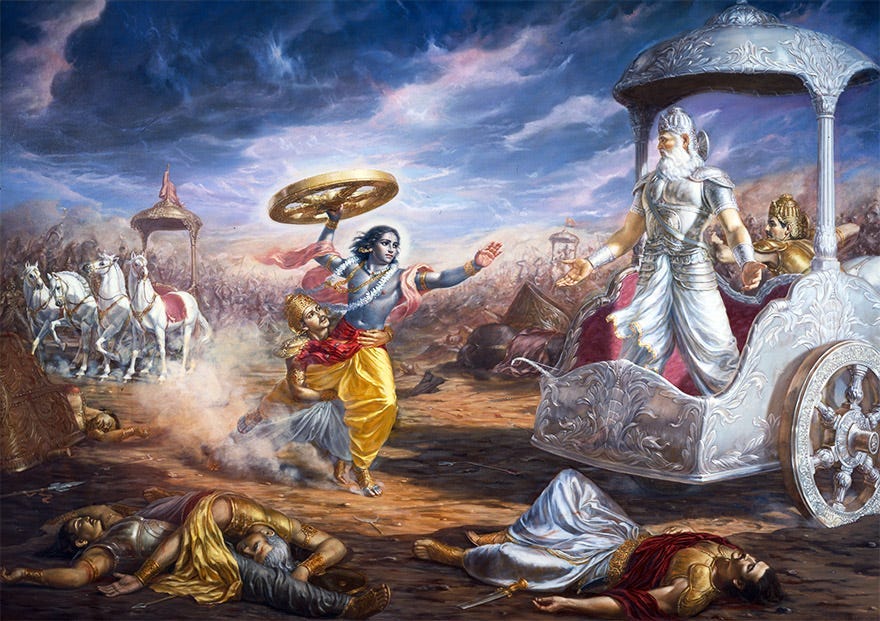Karma, Dharma, and Moksha: Insights from the Bhagavad Gita
Karma teaches us to act selflessly. Dharma guides us to act righteously. Moksha frees us from the cycle of life & death.
The Bhagavad Gita, one of the most revered scriptures of Hindu philosophy, is a profound guide on life’s purpose, ethics, and spiritual fulfillment. It intricately weaves the concepts of Karma (action), Dharma (duty), and Moksha (liberation) into a framework for personal and spiritual growth.
1. Karma: The Philosophy of Action
In the Gita, Lord Krishna emphasizes the significance of selfless action (Nishkama Karma):
Key Teachings:
Do Your Duty Without Attachment:
"Karmanye Vadhikaraste Ma Phaleshu Kadachana"
(You have a right to perform your duties, but you are not entitled to the fruits of your actions.)
Krishna advises Arjuna to act without desire for results, focusing on the action itself.
Renounce the Ego of Doership:
Actions must be performed as an offering to the divine, with humility and devotion. This detachment from results liberates one from anxiety and fosters inner peace.Align Actions with Dharma:
Karma guided by Dharma leads to progress, while selfish or harmful actions cause bondage.
2. Dharma: Living According to Duty
Dharma, or righteous duty, forms the backbone of the Bhagavad Gita’s teachings. It calls for ethical conduct aligned with one's role and responsibilities in life.
Key Teachings:
Follow Your Swadharma:
"Better is one's own dharma, though imperfectly performed, than the dharma of another well performed."
(Chapter 3, Verse 35)
Each individual has a unique purpose (Swadharma) that reflects their nature, talents, and life situation. Fulfilling this personal duty leads to inner growth.
Universal Dharma:
Beyond personal duties, Dharma encompasses universal virtues such as truth, compassion, non-violence, and humility.Stand Up for Righteousness:
Arjuna’s reluctance to fight in the war is addressed by Krishna, who reminds him that abandoning his Dharma as a warrior would lead to dishonor. Acting in alignment with Dharma often requires courage and resilience.
3. Moksha: The Ultimate Liberation
Moksha, or liberation from the cycle of birth and death (samsara), is the ultimate goal of human existence. The Gita provides a roadmap to achieve this through self-realization and union with the divine.
Key Teachings:
Detach from Material Desires:
Attachment to material pleasures and ego binds the soul.
Follow Your Swadharma:
"Better is one's own dharma, though imperfectly performed, than the dharma of another well performed."
(Chapter 3, Verse 35)
Each individual is born into specific circumstances and roles (Swadharma), which are unique to them. Fulfilling these duties with sincerity, even if challenging, is superior to following someone else’s path.
Dharma and Righteousness:
Dharma is not static but dynamic, requiring discernment to act in alignment with the greater good. It is about striking a balance between personal responsibilities and universal ethical principles.Courage in Upholding Dharma:
Krishna encourages Arjuna to embrace his duty as a warrior and fight for justice. Shying away from duty due to fear or attachment leads to moral and spiritual downfall.
3. Moksha: The Ultimate Liberation
Moksha, or liberation, is the culmination of the spiritual journey, where the soul transcends the cycle of birth and death (Samsara) and unites with the divine.
Key Teachings:
Detachment Leads to Liberation:
Moksha is achieved by letting go of desires and attachments, which bind the soul to worldly existence.
"One who is free from dualities, whose mind is established in the self, and who is free from the desire for material possessions, attains liberation."
(Chapter 2, Verse 45)
Surrender to the Divine:
"Sarva-dharman parityajya mam ekam sharanam vraja"
(Abandon all forms of dharma and surrender completely unto Me.)
Surrendering to God’s will dissolves the ego and leads to spiritual freedom.
Jnana (Knowledge) and Bhakti (Devotion):
Knowledge of the self (Atman) and devotion to the divine are paths to Moksha. The Gita emphasizes that true liberation arises from realizing the oneness of the soul with the eternal consciousness.
Interconnection of Karma, Dharma, and Moksha
The Gita harmonizes these three pillars:
Karma is the action you must perform in accordance with Dharma (your righteous duty).
Dharma serves as the guiding principle to ensure actions are aligned with morality and purpose.
By performing selfless actions and upholding Dharma, one transcends the bondage of Karma, ultimately attaining Moksha, the state of eternal bliss.
Practical Insights from the Gita
Balancing Material and Spiritual Life:
Perform worldly duties without losing sight of the spiritual goal.Overcoming Fear and Doubt:
Act with faith in the divine plan, knowing that righteous effort leads to fulfillment.Living with Purpose:
Understanding and embracing one’s Dharma provides clarity and direction in life.
The Bhagavad Gita offers a timeless roadmap for navigating life’s challenges through the synergy of Karma, Dharma, and Moksha. It teaches that every action, guided by righteousness and selflessness, contributes to spiritual evolution, paving the way to ultimate liberation.


